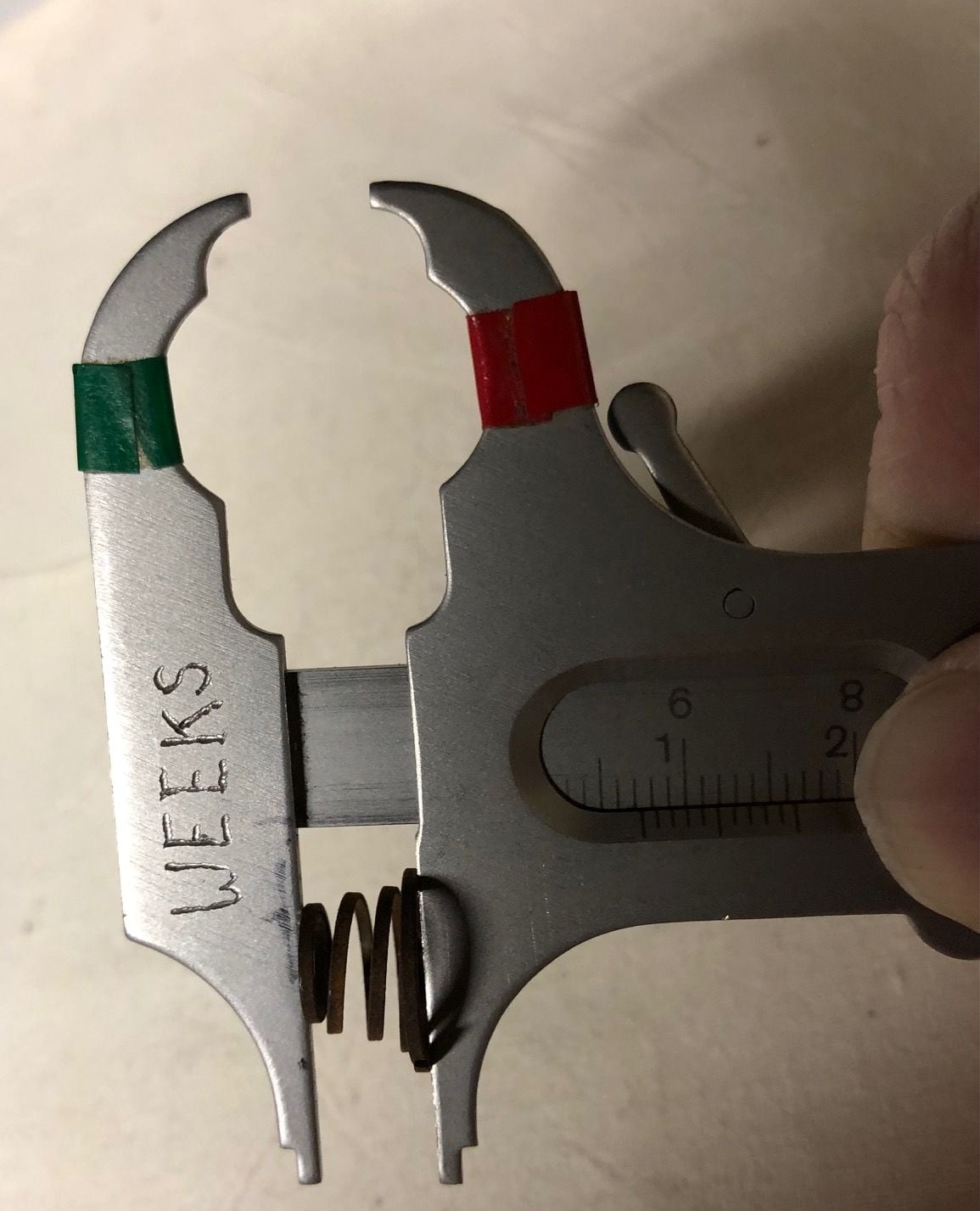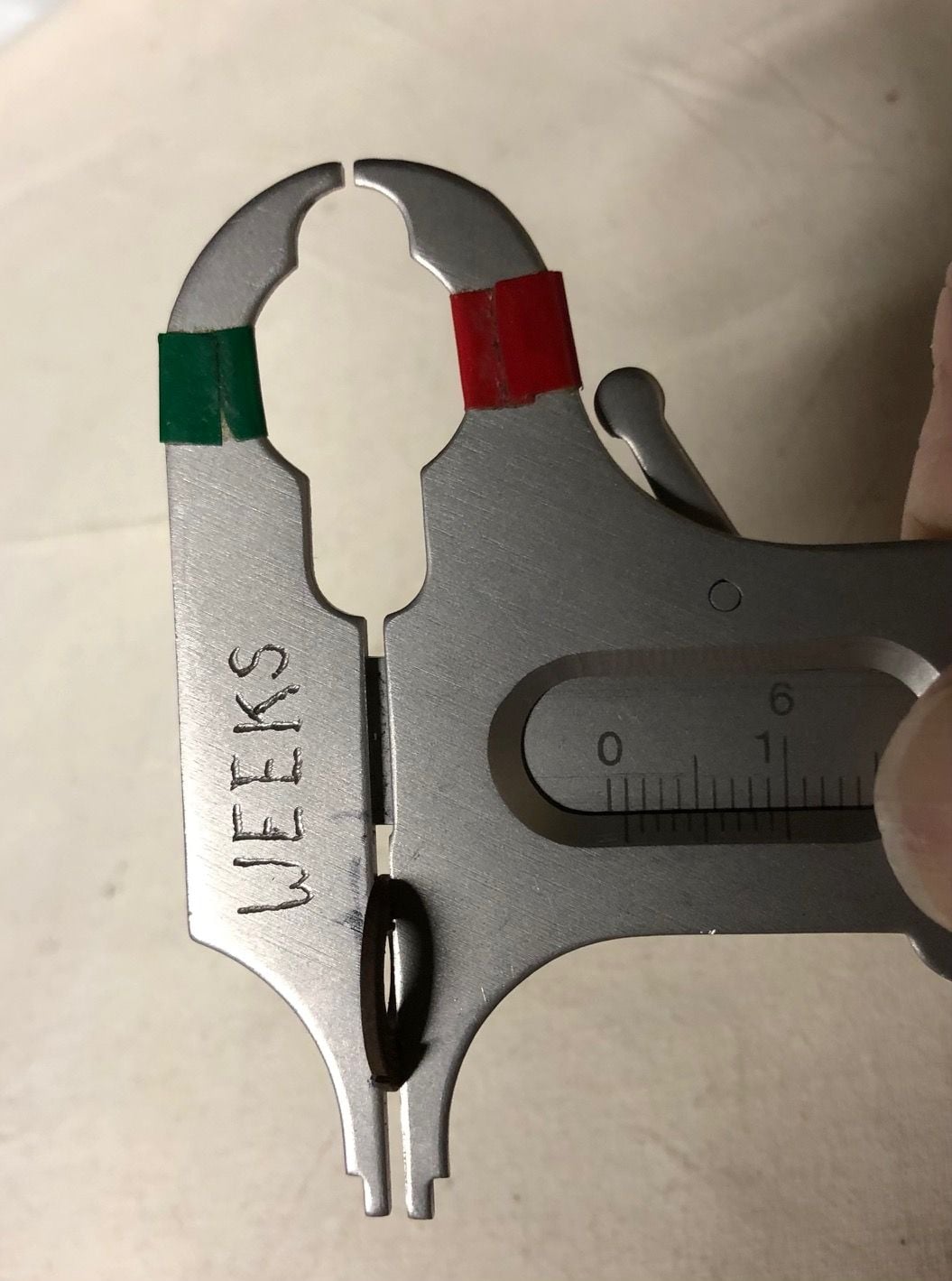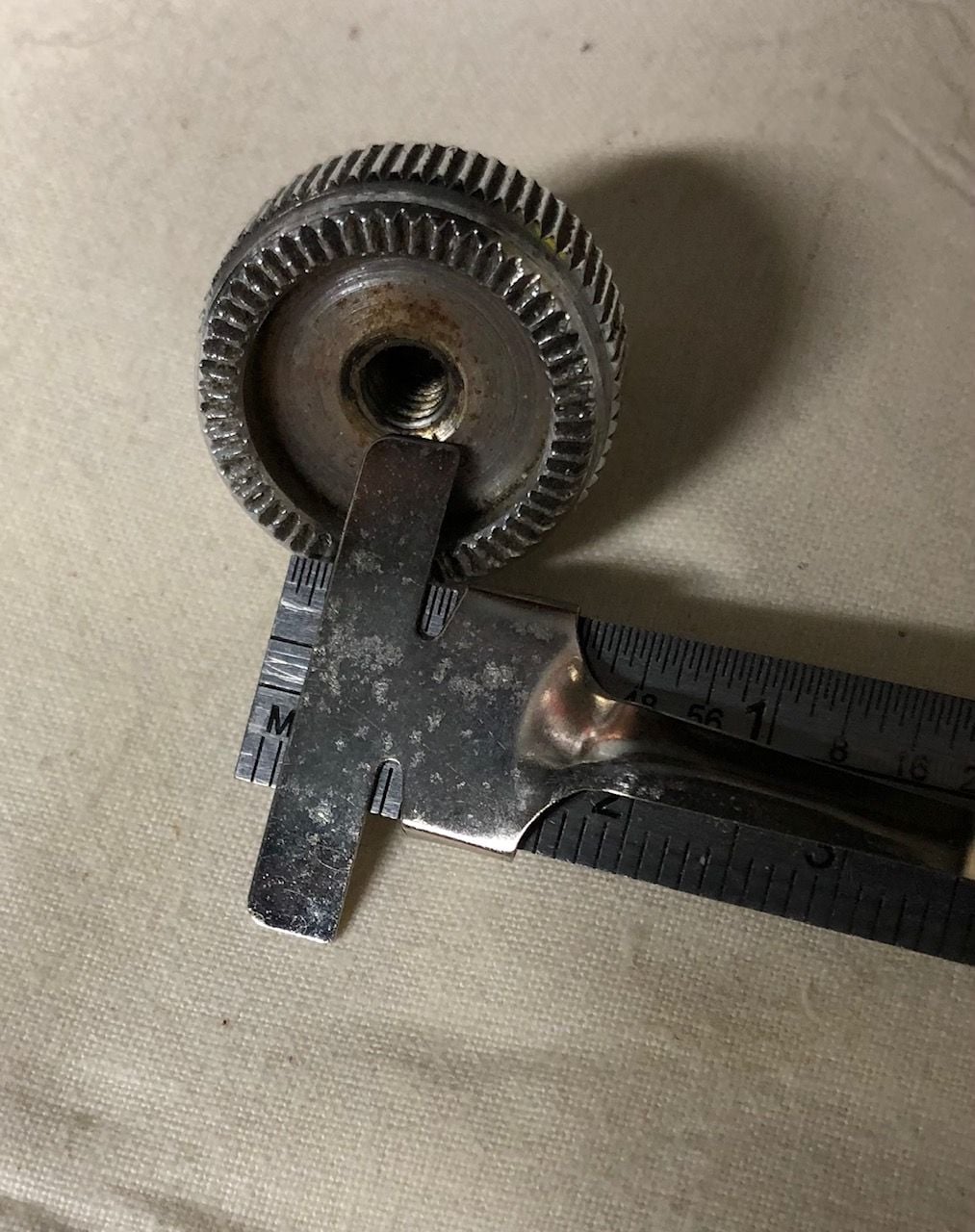Front hub question
#1
Senior Member
Thread Starter
Front hub question
I have a front Zipp 808 Firecrest. If I recollect it is a 2014 V9 18 spoke hub. My issue is no matter what bike I put it on it often will sit cocked or tilted in the forks. What Iíve found though is with some skewers it sits straighter or almost perfectly straight. My friend borrowed it for a TT and saw it distinctly, I offered a known skewer that allows it to be close to perfect and it was good enough that it didnít rub the brake pads. Is this phenomenon just a case of a defective, slightly oversized diameter in the hub, or are bearings trashed orÖ?
Thanks for thoughts.
Thanks for thoughts.
Last edited by Meek; 09-10-22 at 09:09 AM.
#2
Senior Member
Join Date: Jul 2013
Location: Nor-Cal
Posts: 3,767
Bikes: lots
Mentioned: 7 Post(s)
Tagged: 0 Thread(s)
Quoted: 1958 Post(s)
Liked 2,932 Times
in
1,489 Posts
Q/R spring(s) are on in the correct orientation?
#3
Senior Member
Join Date: Feb 2012
Location: Rochester, NY
Posts: 18,050
Bikes: Stewart S&S coupled sport tourer, Stewart Sunday light, Stewart Commuting, Stewart Touring, Co Motion Tandem, Stewart 3-Spd, Stewart Track, Fuji Finest, Mongoose Tomac ATB, GT Bravado ATB, JCP Folder, Stewart 650B ATB
Mentioned: 0 Post(s)
Tagged: 0 Thread(s)
Quoted: 4191 Post(s)
Liked 3,837 Times
in
2,295 Posts
First thing (besides the easy to get wrong QR centering springs) is whether the rim is centered over the axle end caps. This is called "dished". Not mentioned is whether the bike's fork fits a known good wheel on center. Andy
__________________
AndrewRStewart
AndrewRStewart
#4
Senior Member
Join Date: Dec 2020
Location: Wake Forest, NC
Posts: 5,741
Bikes: 1989 Cinelli Supercorsa
Mentioned: 11 Post(s)
Tagged: 0 Thread(s)
Quoted: 3482 Post(s)
Liked 2,903 Times
in
1,764 Posts
How would different QR skewers affect the centering of the wheel?
#5
Senior member
Join Date: Oct 2004
Location: Oakville Ontario
Posts: 8,115
Mentioned: 25 Post(s)
Tagged: 0 Thread(s)
Quoted: 942 Post(s)
Liked 656 Times
in
370 Posts
Not the skewers but the volute springs. If you have them backwards the large end is toward the lock nut and it will interfere with inserting the axle in the dropouts.
Doesnít really have anything to do with centering the wheel but they do centre the skewer in the open position
Doesnít really have anything to do with centering the wheel but they do centre the skewer in the open position
Last edited by Dan Burkhart; 09-10-22 at 11:18 AM.
Likes For Dan Burkhart:
#6
Senior Member
Join Date: Dec 2020
Location: Wake Forest, NC
Posts: 5,741
Bikes: 1989 Cinelli Supercorsa
Mentioned: 11 Post(s)
Tagged: 0 Thread(s)
Quoted: 3482 Post(s)
Liked 2,903 Times
in
1,764 Posts
The OP specifically mentioned using different skewers with different results. Iím talking him at his word and assuming heís got the springs installed correctly.
#7
Senior Member
Join Date: Jul 2005
Location: Boulder County, CO
Posts: 4,389
Bikes: '80 Masi Gran Criterium, '12 Trek Madone, early '60s Frejus track
Mentioned: 6 Post(s)
Tagged: 0 Thread(s)
Quoted: 513 Post(s)
Liked 444 Times
in
334 Posts
To OP, try this. Remove the skewer and springs completely, set the hub in the dropouts, and tell us how it sits.
If it's sitting straight, insert a skewer without springs and tighten. Let us know if anything changes.
If it's still sitting straight, remove the skewer and replace with the springs, narrow end toward center, of course. Tighten and let us know if anything changes.
I know it sounds like I don't know what I'm talking about, and it sounds tedious, but without seeing the actual bike and wheel it's like shooting in the dark.
#8
Senior Member
Join Date: Dec 2020
Location: Wake Forest, NC
Posts: 5,741
Bikes: 1989 Cinelli Supercorsa
Mentioned: 11 Post(s)
Tagged: 0 Thread(s)
Quoted: 3482 Post(s)
Liked 2,903 Times
in
1,764 Posts
Likes For smd4:
#9
Senior Member
Join Date: Sep 2004
Location: Chicago area
Posts: 2,546
Bikes: Airborne "Carpe Diem", Motobecane "Mirage", Trek 6000, Strida 2, Dahon "Helios XL", Dahon "Mu XL", Tern "Verge S11i"
Mentioned: 22 Post(s)
Tagged: 0 Thread(s)
Quoted: 980 Post(s)
Liked 580 Times
in
398 Posts
As you indicated, they wouldn't... unless something else were amiss. I'm wondering if the hub has been taken apart and reassembled with one end not having enough axle protruding beyond the locknut to engage the dropout. This would leave one side of the wheel unsupported. A QR with a lot of clamping force (internal cam) might be able to hold the wheel in position, while one with less force might permit the wheel to get cock-eyed. Also, the "teeth" on some QR ends are harder/sharper than others (eg, steel vs aluminum).
I'd like to suggest that the springs have nothing to do with this issue. I tried to find actual evidence to support this point of view in "Bicycling Science" and "The Dancing Chain", but neither book mentions the springs. Park Tools has nothing on this. Sheldon Brown (HERE) says:
"The conical springs press against the ends of the axle and center the skewer over the dropouts. The narrow end of each spring must rest against the end of the axle. As you tighten the skewer, each of these springs compresses so it fits into a recess in the inner face of the cam or adjusting nut. If a spring is facing the wrong way, it will bend out of shape as you adjust and tighten the quick release."
I'm not going to argue that the springs should be reversed, omitted or anything else. But I think there's a lot of unnecessary attention to the issue of direction, especially as it relates to the position of the wheel. The following images show the evidence for my point of view. I have not evaluated the last part of Sheldon's statement because I'm always putting the springs on with the small ends inward. But I think there's room for doubt. Many of the on-line references I found mention the springs as primarily helping to center the axle in the quick-release for easier insertion into the dropouts, and in this regard having the small end inward is probably helpful. But there is adequate room for the springs inside the QR ends regardless of their orientation.

Here's a skewer spring lightly compressed in a clamp. The spring is made of a spiral of flat steel wire in a conical shape.

The conical shape and the wire's flat profile allow it to compress into a flat disc, which would be up against the dropout (and probably the axle end) on one side, and the inside of the QR end on the other side.

Another view of the spring partially compressed in a caliper.

Here's the spring fully-compressed. It forms a "washer" about one millimeter thick.

This is an older skewer ("M M ATOM"). The caliper shows a 1.0mm gap for comparison.

Here is the QR nut with a depth gauge. There's a bit more than 2mm in the recess; more than enough to accommodate the compressed spring.

This Ultegra QR nut has a bit more than 3mm in the recessed area. The spring wouldn't be fully-compressed inside the tightened QR.
I'd like to suggest that the springs have nothing to do with this issue. I tried to find actual evidence to support this point of view in "Bicycling Science" and "The Dancing Chain", but neither book mentions the springs. Park Tools has nothing on this. Sheldon Brown (HERE) says:
"The conical springs press against the ends of the axle and center the skewer over the dropouts. The narrow end of each spring must rest against the end of the axle. As you tighten the skewer, each of these springs compresses so it fits into a recess in the inner face of the cam or adjusting nut. If a spring is facing the wrong way, it will bend out of shape as you adjust and tighten the quick release."
I'm not going to argue that the springs should be reversed, omitted or anything else. But I think there's a lot of unnecessary attention to the issue of direction, especially as it relates to the position of the wheel. The following images show the evidence for my point of view. I have not evaluated the last part of Sheldon's statement because I'm always putting the springs on with the small ends inward. But I think there's room for doubt. Many of the on-line references I found mention the springs as primarily helping to center the axle in the quick-release for easier insertion into the dropouts, and in this regard having the small end inward is probably helpful. But there is adequate room for the springs inside the QR ends regardless of their orientation.

Here's a skewer spring lightly compressed in a clamp. The spring is made of a spiral of flat steel wire in a conical shape.

The conical shape and the wire's flat profile allow it to compress into a flat disc, which would be up against the dropout (and probably the axle end) on one side, and the inside of the QR end on the other side.

Another view of the spring partially compressed in a caliper.

Here's the spring fully-compressed. It forms a "washer" about one millimeter thick.

This is an older skewer ("M M ATOM"). The caliper shows a 1.0mm gap for comparison.

Here is the QR nut with a depth gauge. There's a bit more than 2mm in the recess; more than enough to accommodate the compressed spring.

This Ultegra QR nut has a bit more than 3mm in the recessed area. The spring wouldn't be fully-compressed inside the tightened QR.
Likes For sweeks:
#10
Senior Member
Join Date: Jul 2013
Location: Nor-Cal
Posts: 3,767
Bikes: lots
Mentioned: 7 Post(s)
Tagged: 0 Thread(s)
Quoted: 1958 Post(s)
Liked 2,932 Times
in
1,489 Posts
People...jesus christ. If you put the q/r springs on backwards the large end will sit over the end of the axle and it won't be possible for the wheel to be centered in the brake pads. It will lean away from whichever side the spring is backwards. How do people not know about this? It doesn't push the wheel off center in the dropouts, it makes it lean to one side at the rim.
Likes For cxwrench:
#11
Senior Member
Join Date: Jul 2005
Location: Boulder County, CO
Posts: 4,389
Bikes: '80 Masi Gran Criterium, '12 Trek Madone, early '60s Frejus track
Mentioned: 6 Post(s)
Tagged: 0 Thread(s)
Quoted: 513 Post(s)
Liked 444 Times
in
334 Posts
I'd like to suggest that the springs have nothing to do with this issue. I tried to find actual evidence to support this point of view in "Bicycling Science" and "The Dancing Chain", but neither book mentions the springs. Park Tools has nothing on this. Sheldon Brown (HERE) says:
Sorry, I don't have an image of this. I made this mistake when I was a neophyte several decades ago, and I've corrected it on dozens of customers' bikes.
Last edited by oldbobcat; 09-10-22 at 04:40 PM.
Likes For oldbobcat:
#12
Thread derailleur
Join Date: Mar 2004
Location: Glendora, CA
Posts: 620
Bikes: Merlin Extralight '94 & Cannondale Supersix '15
Mentioned: 0 Post(s)
Tagged: 0 Thread(s)
Quoted: 358 Post(s)
Liked 449 Times
in
255 Posts
It's easy to check for dish by inserting the wheel in both directions.
It should sit in the same position relative to the brake pads, no matter which way you flip it.
It should sit in the same position relative to the brake pads, no matter which way you flip it.
#13
Senior Member
Join Date: Jul 2013
Location: Nor-Cal
Posts: 3,767
Bikes: lots
Mentioned: 7 Post(s)
Tagged: 0 Thread(s)
Quoted: 1958 Post(s)
Liked 2,932 Times
in
1,489 Posts
I'd like to suggest that the springs have nothing to do with this issue. I tried to find actual evidence to support this point of view in "Bicycling Science" and "The Dancing Chain", but neither book mentions the springs. Park Tools has nothing on this. Sheldon Brown (HERE) says:
. But I think there's a lot of unnecessary attention to the issue of direction, especially as it relates to the position of the wheel.
.
. But I think there's a lot of unnecessary attention to the issue of direction, especially as it relates to the position of the wheel.
.
#14
Senior Member
Join Date: Jul 2005
Location: Boulder County, CO
Posts: 4,389
Bikes: '80 Masi Gran Criterium, '12 Trek Madone, early '60s Frejus track
Mentioned: 6 Post(s)
Tagged: 0 Thread(s)
Quoted: 513 Post(s)
Liked 444 Times
in
334 Posts


OK, here are the photos. The top one shows the spring large-end-to-the-inside. This end of the hub will not seat properly. The bottom one shows correct orientation, small-end-to-the inside. The spring compresses between the axle end and the cam mechanism. This wheel will go in crooked, and insertion and removal might damage the spring.
Last edited by oldbobcat; 09-10-22 at 05:05 PM.
Likes For oldbobcat:
#15
Senior Member
Join Date: Sep 2004
Location: Chicago area
Posts: 2,546
Bikes: Airborne "Carpe Diem", Motobecane "Mirage", Trek 6000, Strida 2, Dahon "Helios XL", Dahon "Mu XL", Tern "Verge S11i"
Mentioned: 22 Post(s)
Tagged: 0 Thread(s)
Quoted: 980 Post(s)
Liked 580 Times
in
398 Posts
If the conical springs are positioned with the wide end to the inside, the spring overlaps the end of the axle, preventing the axle from making direct contact with the dropout. If you do it on both sides of the hub, the hub might go in straight but the brake pads won't mate with the rotor or rim. If you do it on just one side, the wheel will go in cockeyed because on one side it's resting on the axle and on the other it's resting on the spring.
I stand corrected, and I *still* install the springs narrow end inwards! Thinking about how I got my understanding of this issue, I believe I've usually removed the skewer completely, then replaced it and the springs *after* the wheel is placed in the dropouts, so never had the problem of squishing the springs.

OK, here are the photos. The top one shows the spring large-end-to-the-inside. This end of the hub will not seat properly. The bottom one shows correct orientation, small-end-to-the inside. The spring compresses between the axle end and the cam mechanism. This wheel will go in crooked, and insertion and removal might damage the spring.
#16
Senior Member
Join Date: Jul 2013
Location: Nor-Cal
Posts: 3,767
Bikes: lots
Mentioned: 7 Post(s)
Tagged: 0 Thread(s)
Quoted: 1958 Post(s)
Liked 2,932 Times
in
1,489 Posts
As you may have noticed, I was not advocating for the springs to be installed backwards. However, installing them backwards may not always result in problems as my images showed. I see, from the *evidence* presented by OldBobcat, that the springs can be jammed up into the dropout as the axle enters the dropout. I have not seen this in my limited experience. This is how we learn.
Thanks for those images. That is a scenario I had not considered.
I stand corrected, and I *still* install the springs narrow end inwards! Thinking about how I got my understanding of this issue, I believe I've usually removed the skewer completely, then replaced it and the springs *after* the wheel is placed in the dropouts, so never had the problem of squishing the springs.
Thanks for those images. That is a scenario I had not considered.
I stand corrected, and I *still* install the springs narrow end inwards! Thinking about how I got my understanding of this issue, I believe I've usually removed the skewer completely, then replaced it and the springs *after* the wheel is placed in the dropouts, so never had the problem of squishing the springs.










